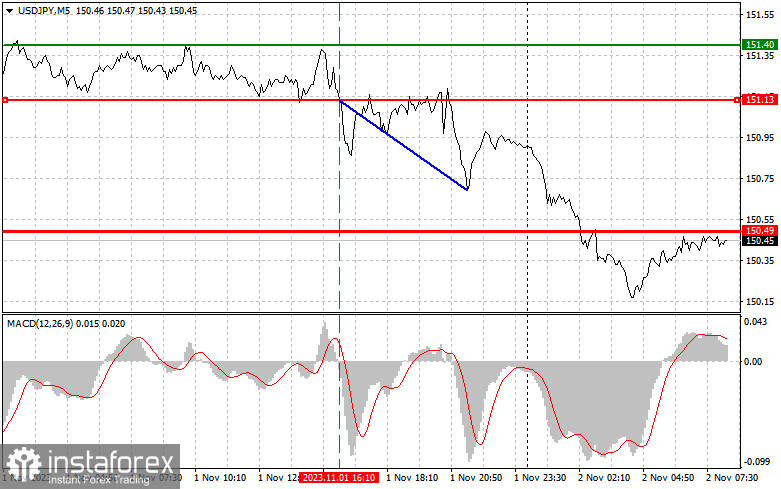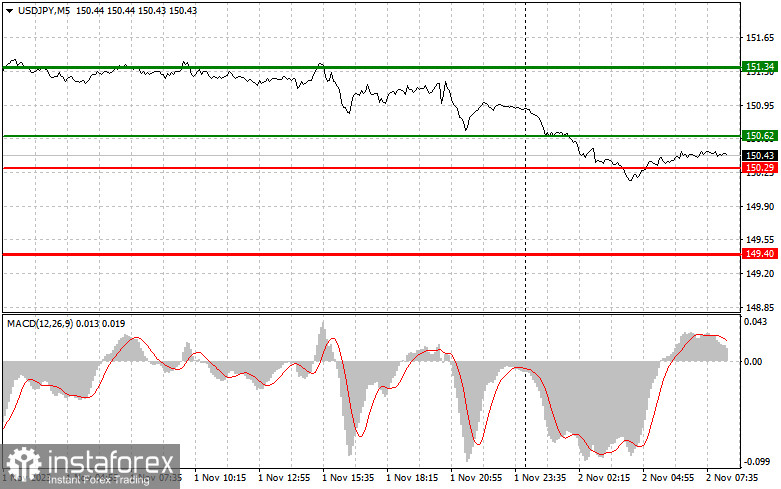The test of the 151.13 price level occurred when the MACD indicator had just started moving down from the zero mark, confirming the correct entry point for selling the pair. As a result, USD/JPY dropped by 40 points. The decision of the Federal Reserve put additional pressure on the dollar, so this time, the Bank of Japan did not intervene. Today, little is expected to change, so sellers will likely try to reclaim the 150 level that they missed before the Fed meeting. If the data on initial jobless claims in the US disappoints traders as much as yesterday's ADP report, the pressure on USD/JPY will only increase. As for intraday prospects, I will act based on the implementation of scenario #1.

Buy Signal
Scenario #1: Buying USD/JPY today is possible when the entry point reaches around 150.62 (green line on the chart) with the aim of reaching 151.34 (thicker green line on the chart). At around 151.34, it is recommended to exit the buy positions and open sales in the opposite direction (anticipating a 30-35 point movement in the opposite direction). Count on the pair's rise only after breaking through the resistance at 150.62 on the back of strong US labor market statistics. Important! Before buying, make sure that the MACD indicator is above the zero mark and is just starting to rise from it.
Scenario #2: You can also buy USD/JPY today in case of two consecutive price tests at 150.29 when the MACD indicator is in oversold territory. This will limit the pair's downward potential and lead to a reversal of the market upward. Expect an increase to the opposite levels of 150.62 and 151.34.
Sell Signal
Scenario #1: Selling USD/JPY today is only possible after updating the level of 150.29 (red line on the chart), which will lead to a rapid decline in the pair. The key target for sellers will be the 149.40 level, where it is recommended to exit sales and immediately open purchases in the opposite direction (anticipating a 20–25 point movement in the opposite direction). Any intervention by the central bank will lead to an immediate sell-off of the pair. Important! Before selling, make sure that the MACD indicator is below the zero mark and is just starting to decline from it.
Scenario #2: You can also sell USD/JPY today in the event of two consecutive price tests at 150.62 when the MACD indicator is in overbought territory. This will limit the pair's upward potential and lead to a market reversal downward. Expect a decline to the opposite levels of 150.29 and 149.40.

On the chart:
Thin green line – the entry price for buying the trading instrument.
Thick green line – the anticipated price at which you can set Take Profit or independently fix profits, as further growth above this level is unlikely.
Thin red line – the entry price for selling the trading instrument.
Thick red line – the anticipated price at which you can set Take Profit or independently fix profits, as further decline below this level is unlikely.
MACD indicator. When entering the market, it is important to consider overbought and oversold zones.
Important. Novice traders in the forex market should be very cautious when making entry decisions. It is best to stay out of the market before important fundamental reports are released to avoid sudden price fluctuations. If you decide to trade during news releases, always set stop orders to minimize losses. Without setting stop orders, you can quickly lose your entire deposit, especially if you do not use money management and trade with large volumes.
And remember that successful trading requires a clear trading plan, similar to the one I presented above. Making spontaneous trading decisions based on the current market situation is inherently a losing strategy for intraday traders.





















